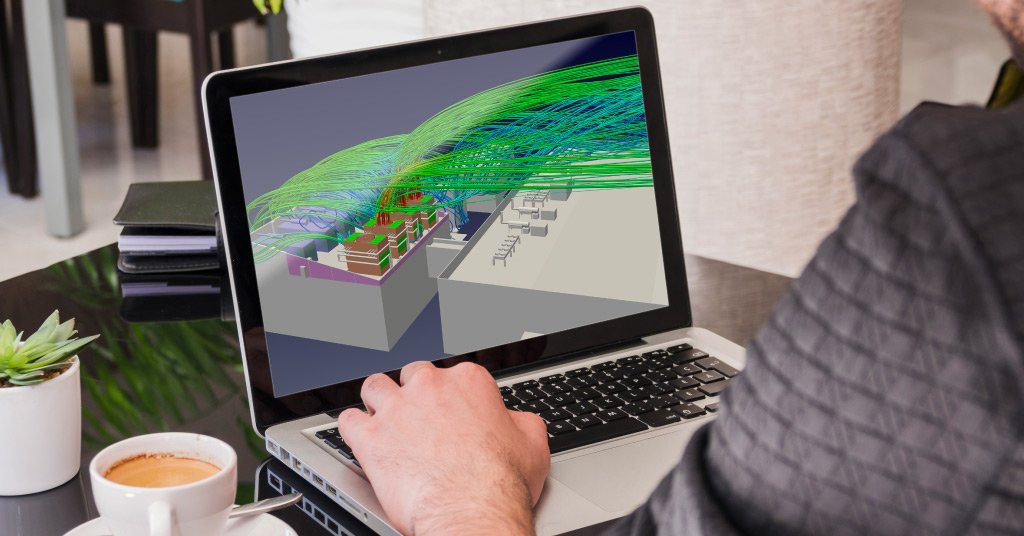Computational fluid dynamics consulting is the process of analyzing and solving problems related to fluid flow in a system and then optimizing the system to operate efficiently using various CFD tools and techniques.
As we know, cooling towers are used to remove heat from systems- HVAC, plants, and buildings- in the form of water vapor flowing through the cooling tower. CFD consulting can be a suitable option to analyze, design, and optimize these cooling towers, mainly to decrease the plume problem, which is a significant health and hazardous concern.
But before we explore how CFD consulting can be used to optimize cooling towers, let’s first understand the concept of CFD.
What is CFD?
CFD (Computational Fluid Dynamics) is a tool designed to study and analyze the flow of fluid to predict its behavior and solve problems through numerical analysis and algorithms in a digital computer program.
It is more accurate, effective, fast, and economical and can solve far more complex problems than conventional methods, which are limited in scope, extremely time-consuming, and often expensive.
CFD is widely used in a variety of fields, including aerospace to study the flow of air around airplane wings, automotive for its aerodynamic analysis; chemical processing to improve the performance of the industrial process; environmental engineering to predict the behavior of the fluid system in natural and built environments, etc.
What Are Plumes And What Are Their Hazards?
Among many problems that come with cooling towers, such as water loss, scaling, corrosion, and noise pollution, the excessive plume is the most concerning because it has a significant effect on humans and the environment. The visible plume is a cloud of water vapors produced by cooling towers.
When plumes come in contact with cold air, they drop pollutants used in cooling towers, namely, scale inhibitors, corrosion inhibitors, biocides, etc., and cause massive air pollution. Consequently, it can spread diseases such as legionnaires, and the people who live near cooling towers could be the subjects to various diseases.
Plumes also have a visual impact as they cause fog formation, which can reduce visibility and cause transportation disruptions, especially in winter. That’s why it is imperative to design a cooling tower to have the minimum effect of plumes on humans and the environment. It can be achieved by CFD consulting for the cooling tower.
How Can CFD Consulting Reduce Plume Release From the Cooling Tower?

-
Predict Plume Dispersion
CFD consultants can create a digital graphic of the movement of the plume dispersion using the CFD tool, which can predict how it will disperse in the atmosphere. Then, this data can be used to find directions and areas where the plume can have a significant impact and ideate a strategy to lessen the impact.
To perform CFD simulation, the primary data, such as the location and size of the cooling tower and any other related factors that might affect the fluid flow, must be considered in the tool. Also, the simulation model needs to evaluate additional data about the fluid’s initial condition, namely, concentration, velocity, temperature, etc.
When the Simulation model is ready, the equation of fluid dynamics will be solved using numerical methods and computer algorithms. This involves disintegrating the environment into a small number of cells and grid points and then solving equations at every point and cell.
The CFD solution can also determine the fluid’s properties at regular intervals. Typically, this process is repeated until the plume has dispersed to detail.
-
Thermal Analysis of the Cooling Tower
The simulation can analyze heat transfer from cooled water to the surrounding atmosphere, which is significant for optimizing the design of the cooling tower and its component to improve the system’s thermal efficiency and minimize the plume effect.
And it is also capable of studying how different conditions, such as water flow rate, temperature, and humidity, affect the cooling towers’ thermal performance. It is instrumental in designing cooling towers optimized for specific conditions and minimizing heat loss.
CFD simulation can also study different material properties of the cooling tower, such as wall and fill materials. It can help you choose better materials for cooling towers that can reduce heat transfer and minimize plume effects.
-
Study the Atmospheric Effect
CFD simulation can also study the different atmospheric conditions of cooling towers, such as humidity, wind speed, and temperature, which can affect plumes. And this information can be used to design cooling towers that are good for specific geographic locations and minimize the plume effect under a range of atmospheric Conditions.
And the CFD can also study the atmospheric stability of the cooling tower. And by doing it, it is possible to predict the plume’s behavior under different atmospheric conditions and optimize the design of the cooling tower.
-
Determine the Flow Pattern of Fluid
CFD can also predict the flow pattern of cooling water when it enters and exit the cooling tower and the air around it. Based on the information consultant get, an optimized cooling tower and its components can be designed, such as a drift eliminator to reduce the velocity of water droplets as they leave the tower and minimize the plume effect.
Parting Note
CFD is a powerful tool that can also help recalibrate the tower’s design and components to improve the overall efficiency of cooling towers. Whereas CFD consulting can aid you in minimizing the plume effect because CFD has been proven to be most effective for HVAC simulation, especially in optimizing cooling towers.
Mechartes has been providing exceptional CFD simulation services and solving complex engineering problems across continents for 15+ years with a team of dedicated CFD engineers and experts. We provide top-notch solutions and guidance with a portfolio of 5000+ finished projects.
Talk to our experts to learn more!


 Share
Share  facebook
facebook